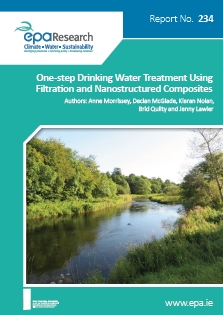Research 234 - One-step Drinking Water Treatment Using Filtration and Nanostructured Composites
Authors: Anne Morrissey, Declan McGlade, Kieran Nolan, Brid Quilty and Jenny Lawler
Summary: This report provides a summary of the findings of the research on the design, development and testing of a novel drinking water treatment system using a combination of filtration and nanostructured composites for the removal of inorganic, organic and microbiological contaminants from water.

Identify Pressures
Sustainable access to clean, safe drinking water has been a key concern in Ireland in recent years, with instances of boil water notices due to the presence of microbial contaminants such as Cryptosporidium parvum and E. coli, being all too frequent. Many drinking water treatment plants do not have the technical capacity to fully eliminate these microbial contaminants. In addition, emerging micropollutants of concern, such as diclofenac, a commonly used nonsteroidal anti-inflammatory drug, are also not fully eliminated in a drinking water treatment process. While levels found in drinking water sources are typically very low (of the ng/L to μg/L order of magnitude), the effects of long term exposure to low levels of these chemicals is unknown.
In order to assure water quality, the development and application of treatment technologies that are capable of removing microbial contaminants, pharmaceutical and personal care products and Hazardous organic materials is apparent. While community access to drinking water varies between public water supplies, group water schemes and private water supplies, there is a need for a variety of drinking water treatment technologies, that can remove both microbial and other micropollutants in the same system, particularly for small water supply schemes. A solution to these pressures is addressed in this report.
Inform Policy
Environmental quality standards for a list of priority substances in surface waters is published in Annex II of the Directive on Environmental Quality Standards (Directive 2008/105/EC) (EQSD). In addition to the priority list, the need for a second list, called a Watch List, was also established for the purpose of supporting future prioritisation exercises. This watch list now comprises of 10 substances as identified in the EU Commission Implementing Decision 2015/495, one of which is diclofenac. This report provides useful information that can aid policy, enforcement and engineering stakeholders work towards an efficient, low cost small scale drinking water treatment system.
Develop Solutions
The key output from this project is an innovative modular drinking water treatment system that can be used for small scale drinking water treatment. The overall system, which incorporates a preliminary ultra-filtration step followed by a prototype consisting of 9 graphene-copper composite coated membranes, was shown to be effective in the adsorption of small organic molecules and the removal and inactivation of microorganisms such as E. Coli and Cryptosporidum parvum. This design can be improved by selecting membranes that are tailored to the pollutant characteristics and by the inclusion of a nano-filtration post-treatment step on a temporary basis to manage standalone pollution events. Other recommended design improvements to avoid membrane rupture, is to use a more porous or “holey” design, similar to a buchner funnel, that better facilitates the distribution of pressure across the membrane.
https://www.epa.ie/media/epa-2020/publications/research/Research_234_thumbnail[1].jpg